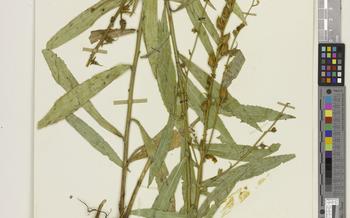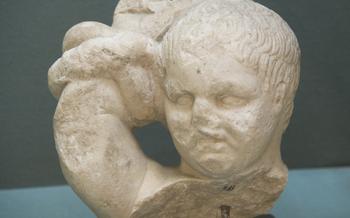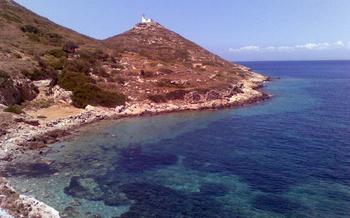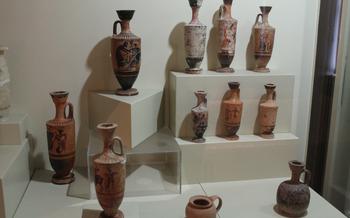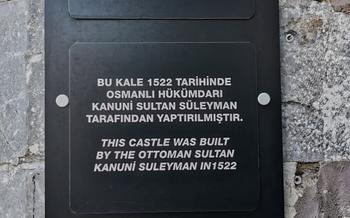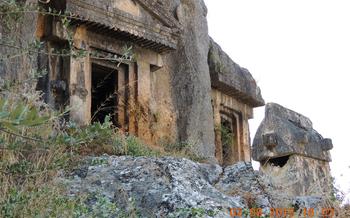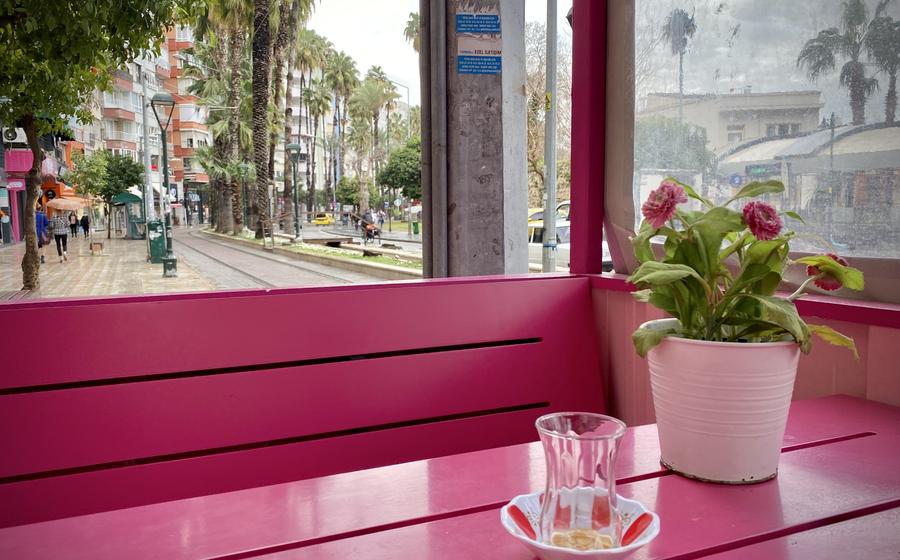
Alanya Archaeological Museum
- Alanya Archaeological Museum
- History of the Museum
- Collections
- Archaeological Discoveries
- Exhibits and Displays
- Unique Artifacts
- Interactive Displays
- Guided Tours
- Educational Programs
- Accessibility
- Museum Shop
- Cafe and Restaurant
- Opening Hours and Admission
- Location and Transportation
- Insider Tip
Alanya Archaeological Museum
In the heart of Turkey's Mediterranean gem, Alanya, nestled amidst rolling hills and the glistening Mediterranean Sea, lies a treasure trove of history and culture—the Alanya Archaeological Museum. This museum takes visitors on a journey through time, showcasing the rich artistic heritage of the region from the Bronze Age to the Ottoman period. Its significance lies in preserving and presenting the fascinating relics that tell the story of Alanya's past, shedding light on the civilizations that have left their mark on this vibrant city.
The exhibits at the Alanya Archaeological Museum are a testament to the region's diverse cultural heritage. From intricate Bronze Age artifacts to awe-inspiring Roman sculptures, the museum offers a glimpse into the artistry and craftsmanship of past civilizations. Visitors can marvel at the delicate pottery and ceramics, intricately carved sculptures, and stunning mosaics that adorn the museum's halls. The museum also houses the Alanya Shipwreck, a remarkable example of ancient seafaring, and the Bronze Statue of Hercules, a symbol of strength and power.
Positioned in the picturesque Alanya Castle, the museum is easily accessible and offers a unique blend of history, culture, and breathtaking views. Whether you're a history buff, an art enthusiast, or simply curious about the past, the Alanya Archaeological Museum promises an enriching and unforgettable experience as you delve into the rich tapestry of civilizations that have shaped this enchanting Turkish city.
History of the Museum
In the early 20th century, as archaeological excavations in the Alanya region intensified, the need for a dedicated museum to house and display the growing collection of artifacts became apparent. In 1967, the Alanya Archaeological Museum was established in the heart of the city, near the iconic Alanya Castle. The museum's initial collection consisted primarily of artifacts recovered from the ancient city of Syedra, located just a few kilometers from Alanya.
The museum's architectural style is a blend of traditional and modern elements, reflecting the history and cultural heritage of the region. The main building, constructed in the 1960s, features a simple yet elegant design with clean lines and spacious galleries. Over the years, the museum has undergone several renovations and expansions to accommodate its growing collection and provide a more comprehensive visitor experience.
In 2012, a new wing was added to the museum, doubling its exhibition space and allowing for the display of larger artifacts and installations. The new wing's design seamlessly integrates with the existing structure, creating a cohesive and modern museum complex. Today, the Alanya Archaeological Museum stands as a testament to the region's rich history and archaeological significance, attracting visitors from around the world.
Collections
The Alanya Archaeological Museum houses a diverse and impressive collection of artifacts that span various historical periods, from the Bronze Age to the Ottoman period. These artifacts provide valuable insights into the rich cultural heritage of the Alanya region and its surrounding areas.
Bronze Age Artifacts
The museum's Bronze Age collection includes a range of tools, weapons, and ornaments that shed light on the early inhabitants of the region. These artifacts showcase the region's technological advancements and artistic traditions during this period.
Hellenistic and Roman Periods
The Hellenistic and Roman periods are represented by an array of pottery, coins, and sculptures. These artifacts reflect the influence of Greek and Roman civilizations on the region. Visitors can admire the intricate designs and motifs that adorned pottery vessels and explore the historical significance of the coins.
Byzantine and Seljuk Periods
The Byzantine and Seljuk periods are well-represented in the museum's collection. Artifacts from these periods include religious objects, pottery, and architectural elements. These artifacts provide a glimpse into the region's religious and cultural practices during these times.
Ottoman Period
The Ottoman period is represented by a variety of objects, including ceramics, textiles, and weaponry. These artifacts showcase the artistic and cultural achievements of the Ottoman Empire and its impact on the region.
Archaeological Discoveries
The Alanya region has been a rich source of archaeological discoveries, shedding light on the diverse civilizations that have inhabited this land. Extensive excavations conducted in the city and its surroundings have yielded a treasure trove of artifacts, providing valuable insights into the past.
Notable findings from these excavations include ancient tools, weapons, pottery, jewelry, and coins, offering glimpses into the daily lives and craftsmanship of past societies. The uncovering of monumental structures, such as temples, theaters, and fortifications, has illuminated the region's architectural heritage and urban planning.
These discoveries have significantly contributed to our understanding of the region's history, helping to reconstruct the political, economic, and cultural dynamics of the various civilizations that have flourished here. The Alanya Archaeological Museum stands as a testament to the richness and diversity of these findings, showcasing the tangible remains of the region's past.
Ongoing research and projects in the Alanya region continue to unearth new archaeological treasures, further enriching our knowledge of this fascinating part of the world.
Exhibits and Displays
The Alanya Archaeological Museum boasts a diverse array of exhibits that showcase the rich cultural heritage of the region. Visitors can marvel at a collection of ancient coins, each telling a story of trade and economy in bygone eras. Exquisite pottery and ceramics, intricately adorned with motifs and patterns, provide a glimpse into the artistry and craftsmanship of past civilizations. Sculptures and statues, carved from marble, bronze, and stone, depict gods, heroes, and mythical creatures, offering insights into the religious beliefs and artistic traditions of the region. Mosaics and frescoes, with their vibrant colors and intricate designs, transport visitors back in time to witness the grandeur and opulence of ancient palaces and villas. These exhibits, meticulously preserved and displayed, offer a captivating journey through the artistic and cultural achievements of the Alanya region throughout history.
Unique Artifacts
Among the awe-inspiring exhibits at the Alanya Archaeological Museum, several unique artifacts stand out as exceptional highlights.
-
The Alanya Shipwreck: Discover the captivating tale of the Alanya Shipwreck, a 7th-century Byzantine merchant vessel that met its fate off the coast of Alanya. This remarkable underwater find has yielded an extraordinary treasure trove of artifacts, including gold coins, intricate jewelry, and well-preserved ceramics, offering a glimpse into the vibrant maritime trade routes of the Byzantine Empire.
-
The Alanya Treasure: Delve into the story of the Alanya Treasure, an astonishing collection of gold and silver coins unearthed in the Alanya Castle. Dating back to the 13th century, these coins bear witness to the immense wealth and prosperity of the Seljuk Sultanate of Rum. The treasure's discovery has shed new light on the economic and political dynamics of this powerful Anatolian kingdom.
-
The Bronze Statue of Hercules: Encounter the imposing Bronze Statue of Hercules, a majestic relic from the Hellenistic period. Towering over two meters in height, this muscular figure embodies the strength and heroism of the mythological hero Hercules. Its intricate details and masterful craftsmanship provide a testament to the artistic prowess of ancient Greek sculptors.
-
The Roman Sarcophagi: Explore the exquisite Roman sarcophagi, intricately carved with scenes from mythology, battles, and everyday life. These elaborate stone coffins offer a poignant glimpse into the funerary practices and beliefs of the Roman Empire. The sarcophagi's exceptional artistry and symbolism provide valuable insights into the cultural and religious traditions of this ancient civilization.
Interactive Displays
Complementing the rich collection of artifacts, the Alanya Archaeological Museum offers a range of interactive displays that bring history to life and enhance the visitor experience. Touchscreens and multimedia presentations provide in-depth information about the artifacts, allowing visitors to explore the historical context and significance of each item. Virtual reality experiences transport visitors back in time, offering immersive simulations of ancient Alanya and its surroundings. 3D models and animations further enhance the visual experience, providing a dynamic and engaging way to learn about the region's past. Educational games and activities, designed for visitors of all ages, make learning about archaeology fun and interactive. These interactive displays not only enhance the educational value of the museum but also cater to the diverse learning styles and interests of visitors, ensuring an enriching and memorable experience.
Guided Tours
The Alanya Archaeological Museum offers guided tours in various languages to enhance visitors' understanding and appreciation of the exhibits. The museum's experienced guides are knowledgeable in Turkish history, archaeology, and the significance of the artifacts on display. They provide insightful commentary and anecdotes, bringing the past to life and making the visit more engaging.
Advance booking is recommended for guided tours, especially for groups or during the peak tourist season. Group discounts are available, making it an affordable option for educational trips or family outings. The museum also offers tailored tours for specific interests, such as ancient history, maritime archaeology, or Islamic art. These specialized tours provide a deeper dive into selected themes and allow visitors to explore the museum's collection from a unique perspective.
Educational Programs
The Alanya Archaeological Museum is committed to promoting education and fostering a deeper understanding of Turkish history and culture. To this end, the museum offers a range of educational programs tailored to students, schools, and universities.
-
Workshops and Lectures: The museum hosts workshops and lectures conducted by experienced archaeologists and historians. These sessions delve into specific aspects of Turkish history, art, and archaeology, providing participants with in-depth knowledge and insights.
-
Outreach Programs: The museum actively engages with schools and universities through outreach programs. Museum educators visit educational institutions to conduct interactive presentations and workshops, bringing the museum's collection and research to life for students.
-
Summer Camps and Events: During the summer months, the museum organizes educational summer camps for children and teenagers. These camps offer a mix of hands-on activities, field trips, and interactive learning experiences related to archaeology and history.
-
Collaborations with Academic Institutions: The museum collaborates with universities and research institutions to facilitate academic research and promote knowledge exchange. Joint projects, internships, and research opportunities are offered to students and scholars interested in Turkish archaeology and cultural heritage.
Accessibility
The Alanya Archaeological Museum is committed to providing an inclusive and accessible experience for all visitors, regardless of their abilities or disabilities. Wheelchair users and visitors with limited mobility can easily navigate the museum's spacious galleries and exhibits. Ramps and elevators connect different levels of the museum, ensuring that everyone can explore the collections comfortably.
For visitors who are deaf or hard of hearing, the museum offers sign language interpretation upon request. Audio guides are also available in several languages, providing detailed descriptions of the exhibits and their historical significance.
To cater to visitors with visual impairments, the museum provides tactile exhibits and descriptive panels that allow them to explore the artifacts through touch. Special programs, such as guided tours and workshops, are also organized to enhance their museum experience.
The museum's commitment to accessibility reflects its belief that everyone should have the opportunity to learn about and appreciate the rich cultural heritage of Alanya and the surrounding region.
Museum Shop
The Alanya Archaeological Museum features a well-stocked museum shop that offers a diverse range of souvenirs and mementos to commemorate your visit. From intricate replicas of ancient artifacts to informative books and publications on Turkish history and archaeology, the shop provides a treasure trove of items to suit every taste and budget.
In addition to the historical offerings, the shop also showcases local handicrafts and traditional textiles, providing an opportunity to support local artisans and take a piece of Alanya's rich culture back home with you. The proceeds from the museum shop play a crucial role in supporting the museum's conservation efforts, ensuring that these priceless artifacts continue to be preserved and showcased for future generations.
Cafe and Restaurant
For visitors seeking a break from exploring the museum's exhibits, there is an on-site cafe serving refreshing beverages and light snacks. For a more substantial meal, the museum also has a restaurant offering a delectable array of traditional Turkish cuisine. While savoring the flavors of Turkish culinary delights, guests can enjoy scenic views of the Alanya Castle and the glistening Mediterranean Sea. During pleasant weather, outdoor seating provides an inviting ambiance for al fresco dining.
Opening Hours and Admission
The Alanya Archaeological Museum welcomes visitors all year round, except on Mondays, which are designated as a day off. From Tuesday to Sunday, the museum's doors are open from 9 am to 5 pm, allowing ample time for exploration and discovery. Regular ticket prices are set at an affordable rate, offering excellent value for the wealth of knowledge and history housed within the museum's walls. Students, seniors, and families are eligible for discounted tickets, providing accessible admission for all. Additionally, the museum offers free entrance on specific days or during special events, making it an even more enticing destination for those seeking cultural enlightenment.
Location and Transportation
The Alanya Archaeological Museum is conveniently situated in the heart of the city, making it easily accessible for visitors. It is located just a short walk from the iconic Alanya Castle and the picturesque harbor, offering stunning views of the Mediterranean Sea. Visitors can easily reach the museum using public transportation, as there are several bus stops within walking distance. For those arriving by car, ample parking facilities are available nearby. Additionally, the museum's proximity to other attractions in Alanya, such as the Red Tower, the Damlatas Caves, and the Alanya Aquapark, makes it an ideal starting point for exploring the city's rich history and natural beauty.
Insider Tip
For a peaceful and uncrowded experience, plan your visit to the Alanya Archaeological Museum early in the morning or late in the afternoon, avoiding the midday rush. Embrace the opportunity to capture the beauty of the artifacts and exhibits through photography, but be mindful of the museum's guidelines and restrictions. While you're in the area, take advantage of the proximity to other attractions, such as the Alanya Castle, the Red Tower, and the Damlataş Cave. Immerse yourself in the local culture by visiting the vibrant markets, sampling the delicious Turkish cuisine, and engaging with the friendly locals. Respect local customs and etiquette, such as dressing modestly and greeting people with a warm "Merhaba" (hello).
